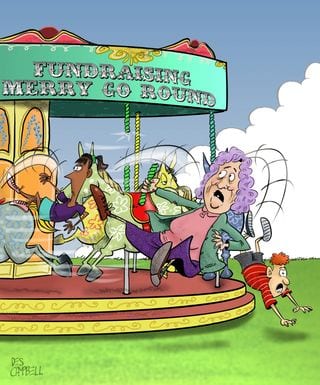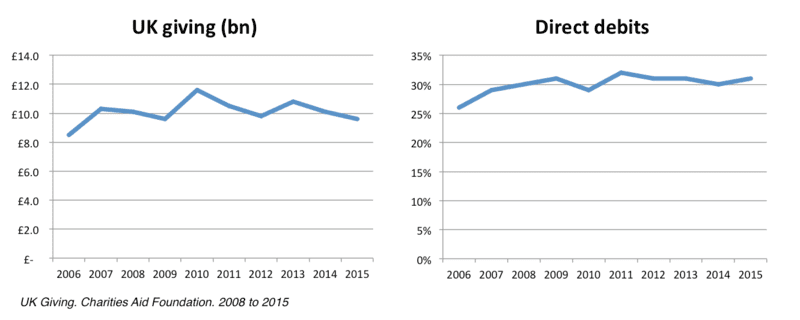Thoughts on the roots of the fundraising crisis and what might happen next
For all the headlines, news reports and criticism of fundraising over the last year, the point that seems to have escaped attention is just how we found ourselves in so much trouble.
It's all too easy to blame elements of the media for whipping up a storm that didn’t exist or pass the buck to "irresponsible" agencies. But that simply deflects us from examining the real causes of a problem that remains ongoing.
And when I say ongoing, I don't mean we are going to see another bruising set of reports from the media (which we may). I'm concerned about the fact that however you look at individual fundraising, over the last few years there has been very little growth. Indicator after indicator shows that fundraising is in the doldrums. And we are likely to be stuck here for a fair number of years to come.
Let’s take some recent reports. First, CAF’s UK Giving. Though some people criticise their methodology, the study has tracked attitudes to giving for a decade. That means it provides a very reliable indicator of trends. And what do we see? Flat-lining of income, donor numbers and direct debits.
Second. Last year’s review of the sector by the NCVO, A Financial Stability Review (PDF) demonstrated that charity income had decoupled from growth in the wider economy (graph here). It also highlighted that where there were gains, it was often down to fees for services rather than through increases in voluntary income.
Third. The Top 100 Fundraising Charities Spotlight published a few weeks ago shows that income has grown for the largest 100 charities over the last year (graph here). But when you dig into the annual accounts of the charities that did well, you find that success rarely comes from traditional mass fundraising. Instead, massive hikes in expenditure, large legacies, events, major gifts or one off appeals are responsible for growth.
Alongside this, we've seen a drop in trust.
So what actually happened to cause all this?
To understand, I think we need to go back the best part of twenty years, to the late 1990s when two things happened to dramatically change the fundraising landscape.
The first was the introduction of paperless Direct Debits. These fundamentally changed the role of TV advertising – allowing direct sign up to a regular gift when a donor called in. It might sound rather quaint, but before then, if a donor agreed to a Direct Debit, you had to send them a mandate to sign. And as you might expect, less engaged donors tended to forget to complete and return these pesky forms.
Second was the massive commercialisation of face-to-face fundraising. Combined, both techniques allowed charities to sign up regular givers without going through the process of engaging them first. TV didn’t really start flying as a recruitment medium until the £2 a month request was introduced. But once that was in place, the two approaches meant that pretty much anyone was a prospect. Whereas once charities wanted donors who had a connection to their cause, now that wasn't particularly important.
Some early face-to-face agencies actually advised their clients not to communicate with these new donors at all, apart from periodic calls to upgrade their gifts.
These techniques worked. There was sector-wide growth in income. Each year, thousands of new regular givers were recruited and, importantly to finance directors, costs and income were ‘guaranteed’. For many organisations, cash programmes took second place. Budgets were often shifted to RG acquisition and it became common for warm appeals to be pitched out to different creative agencies or freelance teams as and when they were needed.
The result was that much continuity was lost. Then in the 2000s, in the drive for more donors, many charities began to adopt commercial branding practices. We saw a number of organisations develop new visual identities and introduce guidelines that dramatically changed the way they described themselves and their work. Some charities even ditched their names and evolved into new entities that were completely unknown to their supporters.
The combined result was that the relationship between charities and their supporters became ever more fragmented. But at the same time, many charities flushed with short-term fundraising success, moved forward with increasingly ambitious plans that required significant growth in giving. Individually, such ambition was fine. But when many organisations were doing the same thing, it’s understandable that without further expansion of the number of people who give, donors would come under pressure.
 And that’s just what we saw happen. Charities, with a few notable exceptions, mailed the same lists, stopped the same people in the street and advertised on the same TV channels with similar offers asking donors to take out yet another low value Direct Debit. It became a little like a merry-go-round with donors switching from one charity to another.
And that’s just what we saw happen. Charities, with a few notable exceptions, mailed the same lists, stopped the same people in the street and advertised on the same TV channels with similar offers asking donors to take out yet another low value Direct Debit. It became a little like a merry-go-round with donors switching from one charity to another.
Engagement fell and donors actively voiced their irritation. I remember back in 2009 when Bluefrog published the biggest UK study ever undertaken into why donors lapse, being shocked by the findings. Donors said they valued the work of charities. But they felt increasingly under-valued as supporters. As a result, charity communications started to become something they tolerated rather than welcomed.
Obviously, many donors continued to have favourite charities that they deeply valued. But, at the same time, they reported feeling under pressure from the wider charity sector. And our research since then shows that nothing has improved. So when the news stories broke and donors could see they were not alone, very few spoke up to defend us.
The sad fact is, when some charities started to treat donors as a commodity, people reciprocated by losing trust and patience with the fundraising practices of the sector as a whole. Lapsed files grew as complaints about 'selling names' became widespread. Continued requests for Direct Debits tired many donors out to the point that they found the solution was simply to agree and then cancel the Direct Debit shortly afterwards. Why else is attrition such a problem?
It is a strange state of affairs that I don’t think the introduction of the FPS is going to resolve. For all the complaints, many donors really do want to stay in contact with some charities and a 'reset button' is not going to be something that 'charity people' are going to happily press. However, the fact is, we need to build an understanding of which donors want to give us the odd gift and those who really value our work enough to give over the long-term.
We'll find more of the latter by focusing on the people who send in unprompted gifts (and they do exist) and actively recruiting people who have more than a passing interest in our particular organisation’s work. And that's rarely achieved by requests for micro donations or tiny Direct Debits.
Which sums up perhaps the biggest problem the sector faces. Donors who don't want a relationship with a charity they 'support' probably won't even notice the change to a donor-centric approach. And heaven knows what will happen to that simple opt-in request when it lands on their mat, arrives in their in-box or buzzes up as an incoming text?
The fact is, over the next few years, opting-in is going to be the new proving ground for fundraisers. Getting someone to sign up to receive our communications will require a real appreciation of donor needs and great fundraising technique. What's more, we are going to have to deliver information and materials to donors that they actually value. The days of the self-congratulatory magazine or heavily branded mailing pack are numbered. And those charities that have spent millions recruiting un-engaged donors might find things rather tough.
The focus will need to switch so donors can support us in the way that actually works for them - rather than working for us. Growth in event fundraising for example, shows that successful innovation is more than just about channel choice.
The reality is that fundraising is going to change as we tackle a daunting learning curve, But, if we get it right, the rewards will become immeasurably higher. The future of fundraising is not more low-value text gifts, automated Direct Debits or premium-led, catch-all direct mail packs. Instead it will be focused on delivering a far more enjoyable experience of being a donor and that will bring people much closer to the causes we work for.
And that could be a very, very good thing not just for fundraisers but for society at large.
Tags In
Related Posts
1 Comment
Comments are closed.
The Essentials

Crack the Code to Regular Giving: Insights, Strategies, and a Special Giveaway!

‘Tis Halloween. Keep to the light and beware the Four Fundraisers of the Apocalypse!

Why do people give? The Donor Participation Project with Louis Diez.

A guide to fundraising on the back of a postcard

What does the latest research tell us about the state of fundraising?







I remember the start of this dynamic well.
What was particularly tragic, as you hint, is that the various methods of “unreal” and disengaged fundraising reinforced each other– so “less popular” charities could compete on the f2f/pdd merry-go-round and therefore feel financially secure enough to justify “corporate” rebranding in a way that took them away from connection with donors. In some notable instances, disability charities (I will mention no names) would brief f2f fundraising teams with a nod and a wink that it was OK to use old-fashioned language about disability on the high street and on the doorstep, while they rebranded to a “pure” beneficiary-led corporate identity in all their written communications.
As I’ve said to you, Mark– the FPS pauses this process of disengagement, it doesn’t end the tragedy of the commons on which it is based. I applaud your continued enthusiasm to get back to real engagement-led fundraising.